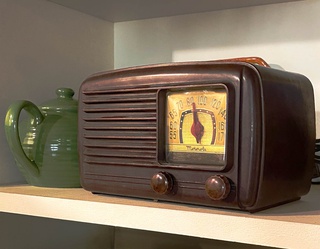
Cannot be improved upon.
There are some ways of doing things that just cannot be improved by technology. One of them, for me, is listening to a baseball game on my early-1950s all-tube kitchen-shelf radio. There's a warmth to the tone that just says “Baseball!” to me, and I love it, dearly. Making the sound ultra-clean with hi-fi equipment, which can definitely be great for certain things, just doesn’t work for a ballgame on the radio. I tune in the Mets or Yankees on my old Motorola and I am there, occasional crackle and all. So it is for me with music too. Doc Watson, Chet Atkins, Wes Montgomery, on an MP3? Nothing in the world quite like vinyl, and companion sales of vinyl for modern recordings have surged in recent years, which says a lot.
Guitar repair and guitar making definitely have their parallels here. CNC (computer numeric controlled) machinery does have its place in guitar making but the final little cuts to make it all come together, that's where the hand-fitting comes into play and becomes part of the minute differences between one guitar and the next. And it is no different with guitar restoration and repairs. A repair person can rely on precise geometry, minute measurements of this and that, all day long, but to sense and judge the wood, its reflexiveness, what it may have been through in the past 20-50-100 years, and to be able to use that sensitivity to judge how to bring an instrument to its best, that's what separates the mathematicians from what we do here, and have always done here. These things need to be felt as much as measured, and there is no substitute for having done it and thought about what was going on all that time. My first major project was when, at the age of sixteen, I dismantled a 1943 Martin D-28 (my very first Martin!) that had already been “repaired” nearly to death, and then re-assembled it. What a learning experience! I loved what I saw and what it took to do what I did with it so much that it led, within the next three or four years, to my becoming the go-to person here in New York for important guitar repairs and restorations. What followed was opening a real guitar store in 1969, where I continued to do the repairs as well. Over the years I transitioned more onto running the business and having a terrific staff to help with both repairs and sales, but I never lost my love and feeling for the instrument itself, the intricacies of each and every one, the innate sensing of what each organic, very individual assemblage of woods was capable of doing to make such great music. And at Matt Umanov Guitars that’s how we continue to approach guitar repair and restoration; employing traditional, time honored techniques with a feel that only comes from decades at the repair bench.
My favorite story ever illustrating all this involves Jimmy D’Aquisto, revered by so many (including me) to have been the only true, Stradivarius-genius-level, guitar maker to ever have lived in America. For those who don’t know of D'Aquisto, his carved-top guitars were beyond the beyond and cherished and sought after by top jazz guitarists everywhere. Jimmy died at the age of 59 in 1995. In the early 1980s Jimmy, who was a very dear friend, was asked to speak at a luthier’s convention about making archtops. Jimmy was not the most conversational person in the world, was not all that comfortable speaking, but he agreed to do it regardless. I was witness to the following: About 15-20 amateurs, semi-pros and pros facing Jimmy in a small room, and while he’s trying to talk the hands keep shooting up. ”How many thousandths of an inch do you….?” “I dunno, I just sorta look”. "How many coats of lacquer before……….?” “When it looks right”. “How many…..?” How much?” “How thick?” Numbers numbers numbers!! Finally, Jimmy, who had a working-class Brooklyn upbringing and a pretty short fuse, exploded, shouting “Hey!! If you ain't got it here (holding out his hands in the air) and you ain't got it here (pounding on his heart, "What the f**k are you doing making guitars???!!!??? Jaws in the audience dropped. Wives jammed elbows into husbands' ribs. I am so thankful to have been there.






